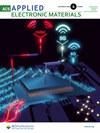Pd-Doped RuO2: A Promising Electrode Material with Battery–Supercapacitor Hybrid Characteristics
IF 4.3
3区 材料科学
Q1 ENGINEERING, ELECTRICAL & ELECTRONIC
引用次数: 0
Abstract
Supercapacitors have emerged as promising energy storage devices due to their high power density, rapid charging/discharging rates, and long cycle life. Ruthenium dioxide (RuO2) is a promising material for supercapacitor electrodes due to its excellent electrical conductivity and pseudocapacitive behavior. Here, we synthesize Ru1–xPdxO2 (x = 0, 0.05, 0.10, and 0.17) by a solid-state route, expecting to alter the electronic structure and specific capacitance with Pd doping. The X-ray diffraction (XRD) analysis suggests that all prepared samples are formed in the desired composition, showing that the crystallite size increases successively with increasing Pd concentration. Cyclic voltammetry (CV) measurements demonstrate that the systematic substitution of 17% Pd in RuO2 contributes to enhancing specific capacitance by ∼15 times (∼1163 F/g) in comparison to parent RuO2 (∼79 F/g), indicating its superior charge storage ability. Further, the decay in specific capacitance with increasing scan rate is only 5% (x = 0.17) in comparison to undoped RuO2, indicating the higher stability of the electrode. The CV of Ru1–xPdxO2 (x = 0.17) exhibits both Faradaic and capacitive electrochemical processes at the electrode/electrolyte interface, suggesting hybrid battery–supercapacitor characteristics. Ru1–xPdxO2 (x = 0.17) represents a promising electrode material for hybrid battery–supercapacitors, offering synergistic enhancements in specific capacitance and stability.

掺钯 RuO2:具有电池-超级电容器混合特性的前景看好的电极材料
超级电容器具有功率密度高、充电/放电速度快、循环寿命长等优点,是一种前景广阔的储能设备。二氧化钌(RuO2)具有优异的导电性和伪电容行为,是一种很有前途的超级电容器电极材料。在此,我们采用固态路线合成了 Ru1-xPdxO2(x = 0、0.05、0.10 和 0.17),期望通过掺杂 Pd 来改变电子结构和比电容。X 射线衍射(XRD)分析表明,所有制备的样品都形成了所需的成分,并显示出结晶尺寸随着钯浓度的增加而逐渐增大。循环伏安法(CV)测量结果表明,与母体 RuO2(∼79 F/g)相比,在 RuO2 中系统地取代 17% 的 Pd 有助于将比电容提高 ∼15 倍(∼1163 F/g),这表明 RuO2 具有卓越的电荷存储能力。此外,与未掺杂的 RuO2 相比,随着扫描速率的增加,比电容的衰减仅为 5%(x = 0.17),这表明该电极具有更高的稳定性。Ru1-xPdxO2 (x = 0.17) 的 CV 在电极/电解质界面上表现出法拉第电化学过程和电容性电化学过程,显示出混合电池-超级电容器特性。Ru1-xPdxO2 (x = 0.17) 是一种很有前途的混合电池-超级电容器电极材料,可协同提高比电容和稳定性。
本文章由计算机程序翻译,如有差异,请以英文原文为准。
求助全文
约1分钟内获得全文
求助全文

 求助内容:
求助内容: 应助结果提醒方式:
应助结果提醒方式:


